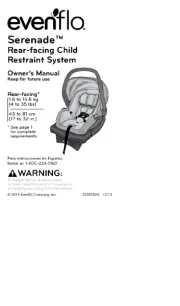Evenflo LiteMax 35 Handleiding
Evenflo
Autostoeltjes
LiteMax 35
Bekijk gratis de handleiding van Evenflo LiteMax 35 (120 pagina’s), behorend tot de categorie Autostoeltjes. Deze gids werd als nuttig beoordeeld door 66 mensen en kreeg gemiddeld 4.5 sterren uit 33.5 reviews. Heb je een vraag over Evenflo LiteMax 35 of wil je andere gebruikers van dit product iets vragen? Stel een vraag
Pagina 1/120

Recline Indicator
Indicateur d’inclinaison
1.8-9 kg (4-20 lbs)
9-15.8 kg (20-35 lbs)
P
L
A
C
E
A
T
A
R
M
P
I
T
L
E
V
E
L
P
U
S
H
© Evenflo Company, Inc. 25701574 02/20
LiteMax™ 35 / SafeMax™
Rear-facing
Child Restraint System
Owner’s Manual
Keep for future use.
Para instrucciones en Español,
llamar al: 1-800-233-5921
To reduce the risk of serious injury or
death, read this owner’s manual prior to
installing and using this child restraint.
WARNING:

2
More children are killed every year as
passengers in car crashes than by any other
type of injury.
To reduce the risk of SERIOUS INJURY or DEATH,
read this owner’s manual and your vehicle owner’s
manual before installing and using this child
restraint.
Using a child restraint makes a big difference. By
properly using this child restraint and following
these instructions (and the instructions that
accompany your vehicle), you will greatly reduce
the risk of serious injury or death to your child from
a crash.
Do not be misled by the commonly used term
“safety seat”; no restraint system can prevent all
injuries in all crashes. Many properly restrained
adults and children are injured in motor vehicle
crashes, including relatively minor crashes.
A properly used child restraint is the best way to
minimize injuries to your child and to increase the
chances for your child’s survival in most crashes.
Product specificaties
| Merk: | Evenflo |
| Categorie: | Autostoeltjes |
| Model: | LiteMax 35 |
Heb je hulp nodig?
Als je hulp nodig hebt met Evenflo LiteMax 35 stel dan hieronder een vraag en andere gebruikers zullen je antwoorden
Handleiding Autostoeltjes Evenflo

3 Oktober 2022

3 Oktober 2022

3 Oktober 2022

3 Oktober 2022
Handleiding Autostoeltjes
- Chicco
- Osann
- Bebe Stars
- Bebe Confort
- Lorelli
- Joycare
- Joie
- Kinderkraft
- Britax
- Foppapedretti
- Ultimate Speed
- Be Cool
- Renolux
- Brevi
- Recaro
Nieuwste handleidingen voor Autostoeltjes

3 Oktober 2022

3 Oktober 2022

3 Oktober 2022

3 Oktober 2022

3 Oktober 2022

3 Oktober 2022

3 Oktober 2022

3 Oktober 2022

3 Oktober 2022

3 Oktober 2022